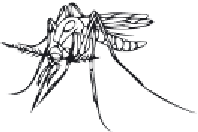Biomedical Engineering Reference
In-Depth Information
This technique does not directly lead to a solution, but enables you to get rid of “sacred cows”
and start to think laterally. The obvious extension to this is to also use word association as
sometimes a different word sparks an idea, for example “stiff - rigid.”
6.4.3 Analogue
Analogue (noun
)
- a thing, idea, or institution that is similar to or has the same function as
another.
The idea is to think of an analogy that you can attribute to the problem you are trying to
address. Analogues are commonplace in theoretical modeling of systems that are hard to
understand - the first port of call is to find something that is similar (its analogue). The
analogues are nearly always from the physical world and, hence, drawn from experience. If,
for example, you were trying to design a frame to aid ambulation for persons with disabilities
you may look at other things than humans walking - any biped would do, e.g., penguins,
cranes, gorillas, etc. (
Figure 6.3
). This is a very powerful idea generation method as it makes
you (excuse the jargon) think outside the box.
As a further example of analogues there is a new engineering discipline (
biomimetics
) that
looks at the biological world and tries to use the lessons of nature to solve engineering
problems. A common analogue is that between the hypodermic syringe and a mosquito
(
Figure 6.4
).
Figure 6.3
Analogy of “walking” to generate ideas.
Figure 6.4
Analogue between a hypodermic syringe and a mosquito.


























































































































Search WWH ::

Custom Search